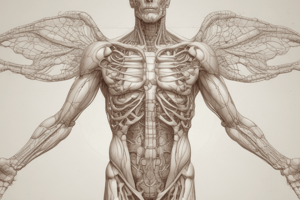Podcast
Questions and Answers
Where are the mediastinal lymph nodes located?
Where are the mediastinal lymph nodes located?
- In the middle compartment
- In the anterior compartment
- They are divided into visceral and parietal groups and located in the posterior compartment
- In the posterior compartment (correct)
Which structure is NOT found in the anterior compartment of the mediastinum?
Which structure is NOT found in the anterior compartment of the mediastinum?
- Thymus gland
- Ascending aorta
- Esophagus (correct)
- Superior vena cava
In which portion of the mediastinum are the great vessels and trachea located?
In which portion of the mediastinum are the great vessels and trachea located?
- Posterior compartment
- Superior region
- Anterior compartment
- Middle compartment (correct)
What borders the mediastinum laterally?
What borders the mediastinum laterally?
Which region of the mediastinum contains structures such as the descending aorta and esophagus?
Which region of the mediastinum contains structures such as the descending aorta and esophagus?
Which division of mediastinum is located below the level of the junction of the manubrium–body of the sternum?
Which division of mediastinum is located below the level of the junction of the manubrium–body of the sternum?
Which group do the parasternal and diaphragmatic lymph nodes belong to?
Which group do the parasternal and diaphragmatic lymph nodes belong to?
What do the paratracheal lymph nodes drain?
What do the paratracheal lymph nodes drain?
Which mediastinal line is formed by the apposition of visceral and parietal pleura of the posteromedial portion?
Which mediastinal line is formed by the apposition of visceral and parietal pleura of the posteromedial portion?
How many parts can the mediastinum be divided into based on different classification systems?
How many parts can the mediastinum be divided into based on different classification systems?
Flashcards are hidden until you start studying
Study Notes
Mediastinum: Structure and Compartments
The mediastinum is a space in the chest that contains all the principal organs and tissues of the thoracic cavity, excluding the lungs. It is located between the lungs, and extends from the sternum to the vertebral column. The mediastinum is bordered laterally by the pericardium, which encloses the heart, and the mediastinal pleurae, which are continuous with those lining the thoracic cage.
Compartments
The mediastinum is traditionally divided into several compartments for clinical purposes. These compartments include the anterior, middle, posterior, and superior regions. The anterior compartment lies in front of the heart, between the heart and the breastbone. Structures inside this compartment include the ascending aorta, superior vena cava, azygous vein, and the thymus gland.
The middle compartment contains the heart, the great vessels, and the trachea. It is the visceral compartment and is the middle part of the mediastinum. Structures inside this compartment include the heart, the great vessels, and the trachea.
The posterior compartment is located behind the heart, between the heart and the spine. Structures in this compartment include the descending aorta, esophagus, vagus nerve, thoracic duct, and the sympathetic chain. The mediastinal lymph nodes are also included in this compartment, which are divided into visceral and parietal groups.
The superior compartment extends from the thoracic inlet to the level of the junction of the manubrium–body of the sternum, around the level of the 4th thoracic vertebra. Below this level, the mediastinum is divided into anterior, middle, and posterior divisions.
Lymph Nodes
The mediastinal lymph nodes are an integral part of the lymphatic system. These lymph nodes are divided into visceral and parietal groups. The parietal lymph nodes are the parasternal and diaphragmatic lymph nodes. The rest belong to the visceral group. Lymphatic drainage from the lung, esophagus, trachea, and thymus is via the paratracheal lymph nodes. The parasternal lymph nodes drain the pleura and chest wall, including the breasts.
Lines
Mediastinal lines are areas of contact between the mediastinum and lung. They are visible on chest radiography when they are tangential to the X-ray beam. A visible shift of these lines may be indicative of a space-occupying lesion of the corresponding mediastinal compartment. The posterior junction line is formed by the apposition of the visceral and parietal pleura of the posteromedial portion of the mediastinum. The subclavian-heart line is the counterpart of the posterior junction line and is also called the anterior junction line.
Functions
The mediastinum has several important functions. It is a space in the chest that contains the heart and other vital structures. It is located between the two pleural cavities and is the middle section of the thoracic cavity. The mediastinum is also a three-dimensional space that is arranged in a particular way to help the body function. It can be divided into either three or four parts, depending on the classification system used.
Studying That Suits You
Use AI to generate personalized quizzes and flashcards to suit your learning preferences.




